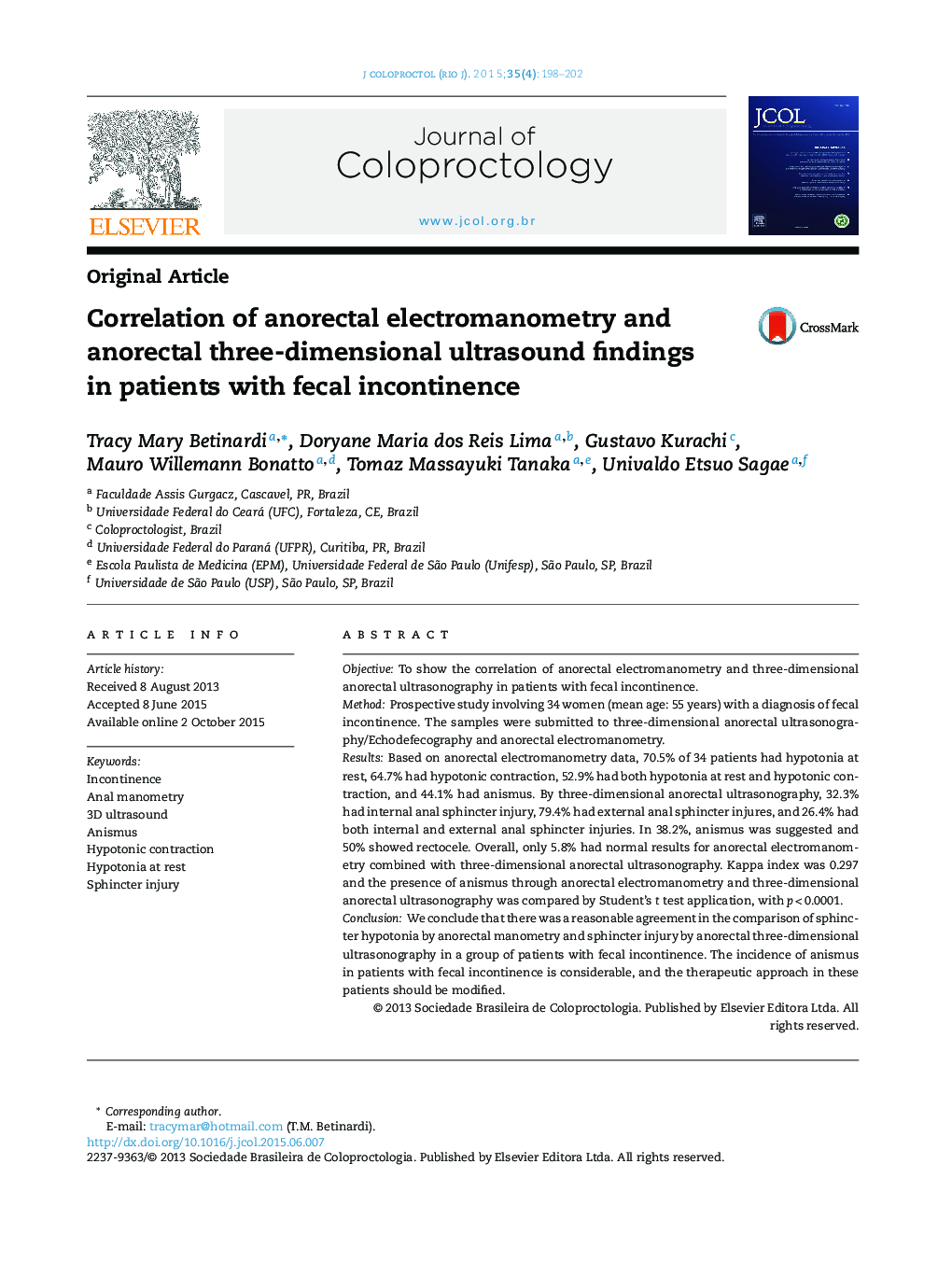| کد مقاله | کد نشریه | سال انتشار | مقاله انگلیسی | نسخه تمام متن |
|---|---|---|---|---|
| 4297097 | 1288243 | 2015 | 5 صفحه PDF | دانلود رایگان |
ObjectiveTo show the correlation of anorectal electromanometry and three-dimensional anorectal ultrasonography in patients with fecal incontinence.MethodProspective study involving 34 women (mean age: 55 years) with a diagnosis of fecal incontinence. The samples were submitted to three-dimensional anorectal ultrasonography/Echodefecography and anorectal electromanometry.ResultsBased on anorectal electromanometry data, 70.5% of 34 patients had hypotonia at rest, 64.7% had hypotonic contraction, 52.9% had both hypotonia at rest and hypotonic contraction, and 44.1% had anismus. By three-dimensional anorectal ultrasonography, 32.3% had internal anal sphincter injury, 79.4% had external anal sphincter injures, and 26.4% had both internal and external anal sphincter injuries. In 38.2%, anismus was suggested and 50% showed rectocele. Overall, only 5.8% had normal results for anorectal electromanometry combined with three-dimensional anorectal ultrasonography. Kappa index was 0.297 and the presence of anismus through anorectal electromanometry and three-dimensional anorectal ultrasonography was compared by Student's t test application, with p < 0.0001.ConclusionWe conclude that there was a reasonable agreement in the comparison of sphincter hypotonia by anorectal manometry and sphincter injury by anorectal three-dimensional ultrasonography in a group of patients with fecal incontinence. The incidence of anismus in patients with fecal incontinence is considerable, and the therapeutic approach in these patients should be modified.
ResumoObjetivoDemonstrar a correlação entre eletromanometria anorretal (EMAR) e ultrassonografia tridimensional anorretal (3D-US) em pacientes com incontinência fecal.MétodoEstudo prospectivo envolvendo 34 mulheres (media de idade: 55 anos) com diagnóstico de incontinência fecal. As amostras foram submetidas à 3D-US/Ecodefecografia e EMAR.ResultadosCom base nos dados de EMAR, 70,5% das 34 pacientes exibiam hipotonia em repouso, 64,7% exibiam contração hipotônica, 52,9% hipotonia em repouso e contração hipotônica, e 44,1% exibiam anismus. Com base nos achados de 3D-US, 32,3% exibiam lesão no esfíncter anal interno, 79,4% exibiam lesão no esfíncter anal externo, e 26,4% em ambos os esfíncteres anais interno e externo. Pela 3D-US, em 38,2% das pacientes houve indício de anismus, e em 50%, retocele. No total, apenas 5,8% obtiveram resultados normais combinados para EMAR e 3D-US. Foi constatado um índice Kappa = 0,297 e, no teste t de Student, a comparação de anismus por EMAR e por 3D-US obteve significância de p < 0,0001.ConclusãoConcluímos ter havido concordância razoável ao ser comparada a manomatria anorretal para hipotonia esfinctérica e a ultrassonografia tridimensional anorretal para lesão esfinctérica em um grupo de pacientes com incontinência fecal. A incidência de anismus em pacientes com incontinência fecal é considerável, e a abordagem terapêutica para esses pacientes deve ser modificada.
Journal: Journal of Coloproctology - Volume 35, Issue 4, October–December 2015, Pages 198–202
